专业英语(翻译版)
- 格式:doc
- 大小:70.00 KB
- 文档页数:7
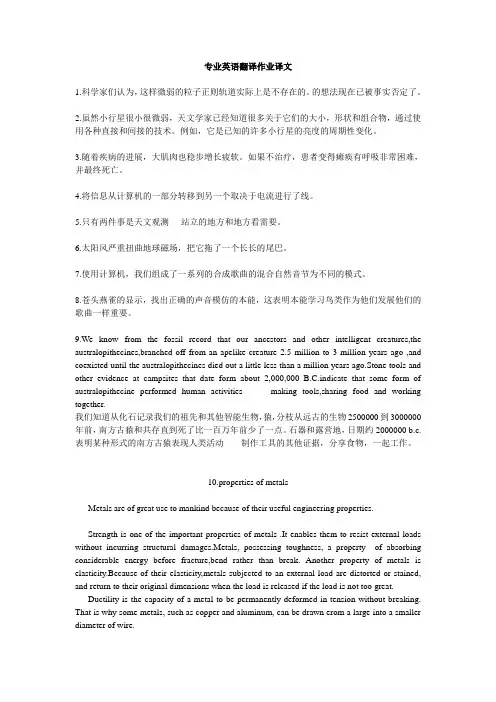
专业英语翻译作业译文1.科学家们认为,这样微弱的粒子正则轨道实际上是不存在的。
的想法现在已被事实否定了。
2.虽然小行星很小很微弱,天文学家已经知道很多关于它们的大小,形状和组合物,通过使用各种直接和间接的技术。
例如,它是已知的许多小行星的亮度的周期性变化。
3.随着疾病的进展,大肌肉也稳步增长疲软。
如果不治疗,患者变得瘫痪有呼吸非常困难,并最终死亡。
4.将信息从计算机的一部分转移到另一个取决于电流进行了线。
5.只有两件事是天文观测----站立的地方和地方看需要。
6.太阳风严重扭曲地球磁场,把它拖了一个长长的尾巴。
7.使用计算机,我们组成了一系列的合成歌曲的混合自然音节为不同的模式。
8.苍头燕雀的显示,找出正确的声音模仿的本能,这表明本能学习鸟类作为他们发展他们的歌曲一样重要。
9.We know from the fossil record that our ancestors and other intelligent creatures,the australopithecines,branched off from an apelike creature 2.5 million to 3 million years ago ,and coexisted until the australopithecines died out a little less than a million years ago.Stone tools and other evidence at campsites that date form about 2,000,000 B.C.indicate that some form of australopithecine performed human activities ------ making tools,sharing food and working together.我们知道从化石记录我们的祖先和其他智能生物,猿,分枝从远古的生物2500000到3000000年前,南方古猿和共存直到死了比一百万年前少了一点。
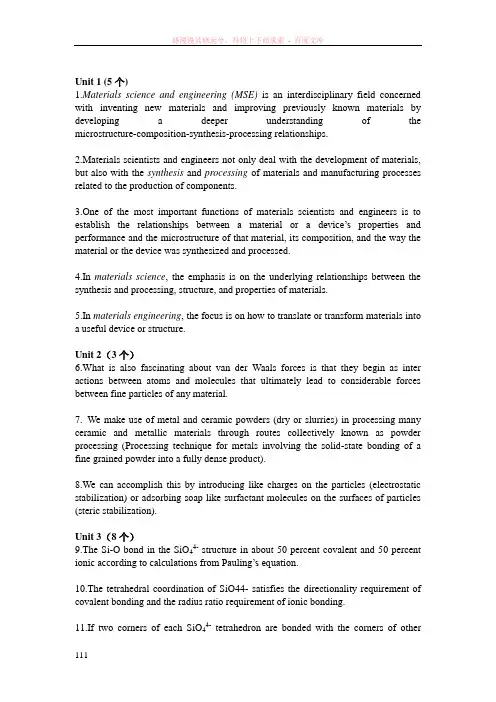
Unit 1 (5个)1.Materials science and engineering (MSE) is an interdisciplinary field concerned with inventing new materials and improving previously known materials by developing a deeper understanding of the microstructure-composition-synthesis-processing relationships.2.Materials scientists and engineers not only deal with the development of materials, but also with the synthesis and processing of materials and manufacturing processes related to the production of components.3.One of the most important functions of materials scientists and engineers is to establish the relationships between a material or a device’s properties and performance and the microstructure of that material, its composition, and the way the material or the device was synthesized and processed.4.In materials science, the emphasis is on the underlying relationships between the synthesis and processing, structure, and properties of materials.5.In materials engineering, the focus is on how to translate or transform materials intoa useful device or structure.Unit 2(3个)6.What is also fascinating about van der Waals forces is that they begin as inter actions between atoms and molecules that ultimately lead to considerable forces between fine particles of any material.7. We make use of metal and ceramic powders (dry or slurries) in processing many ceramic and metallic materials through routes collectively known as powder processing (Processing technique for metals involving the solid-state bonding of a fine grained powder into a fully dense product).8.We can accomplish this by introducing like charges on the particles (electrostatic stabilization) or adsorbing soap like surfactant molecules on the surfaces of particles (steric stabilization).Unit 3(8个)9.The Si-O bond in the SiO44- structure in about 50 percent covalent and 50 percent ionic according to calculations from Pauling’s equation.10.The tetrahedral coordination of SiO44- satisfies the directionality requirement of covalent bonding and the radius ratio requirement of ionic bonding.11.If two corners of each SiO44-tetrahedron are bonded with the corners of othertetrahedra, a chain or ring structure with the unit chemical formula of SiO32- results.12.Silicate sheet structure form when three corners in the same plane of a silicate tetrahedron are bonded to the corners of three silicate tetrahedra.13.The mineral['mɪnərəl](矿物的,矿物) kaolinite['keɪəlɪnaɪt] (高岭石) consists (in its pure form) of every small, flat plates roughly hexagonal[hek'sæɡənəl](六边的,六角形的) in shape, with their average size being about 0.7um in diameter[daɪ'æmɪtə](直径)and 0.05 um thick.14.Another example of a sheet silicate is the mineral talc [tælk](滑石;云母), in which a sheet of Mg3(OH)24+ bonds with two outer-layer Si2O52- sheets (one on each side) to form a composite['kɒmpəzɪt](复合的;合成的)sheet with the unit chemical formula['fɔːmjʊlə](公式,方程式) Mg3(OH)2(Si2O5)2.15.Crystalline['krɪst(ə)laɪn](结晶的)silica exists in several polymorphic[,pɒlɪ'mɔːfɪk](多态的)forms that correspond to different ways in which the silicate tetrahedral are arranged with all corners shared.16.The most stable forms of silica and the temperature ranges in which they exist at atmospheric pressure are low quartz[kwɔːts](石英) below 573℃, high quartz between 573 to 867℃, high tridymite['trɪdɪmaɪt](鳞石英)between 867 and 1470℃, and high cristobite[kris'təu,bəlait](方石英) between 1470 and 1710℃.Unit 4(15个)17.Point defects(点缺陷)are localized['lokə'laɪzd](局部的;地区的;小范围的) disruptions[dɪs'rʌpʃən](破坏)in otherwise perfect atomic or ionic arrangements in a crystal structure.18.These imperfections, may be introduced by movement of the atoms or ions when they gain energy by heating, during processing of the material, by introduction of impurities, or doping[dop](掺杂).19.An important "point" about point defects is that although the defect occurs at one or two sites, their presence is "felt" over much larger distances in the crystalline material.20. When atoms or ions are missing (i.e., when vacancies are present), the overall randomness['rændəmnɪs](随意;无安排;不可测性) or entropy['entrəpɪ](熵) of the material increases, which increases the thermodynamic[,θɜːməʊdaɪ'næmɪk](热力学的)stability of a crystalline material.21.Vacancies['vekənsi](空位)play an important role in determining the rate at whichatoms or ions can move around, or diffuse[dɪ'f juːz](弥散,扩散)in a solid material, especially in pure metals.22.If we conduct(管理;引导;表现) this sintering['sɪntərɪŋ](烧结) treatment in a reducing or inert atmosphere (e.g., hydrogen or nitrogen), some of the oxygen ions from BaTiOa will leave the material in the form of oxygen gas.23.In some cases, we can introduce vacancies at specific ion sites so as to enhance the movement of ions in ceramic materials, which can help sinter ceramics[ɪn'hɑːns](提高;加强;增加) at lower temperatures.24.At room temperature(~298K), the concentration [kɒns(ə)n'treɪʃ(ə)n](集中,浓度)of vacancies is small, but the concentration of vacancies increases exponentially[,ɛkspo'nɛnʃəli](以指数方式) as we increase the temperature, as shown by the following Arrhenius type behavior:25.Interstitial[,ɪntə'stɪʃ(ə)l](间质的;空隙的;填隙的) atoms or ions,although much smaller than the atoms or ions located at the lattice['lætɪs](晶格;格子) points,are still larger than the interstitial sites that they occupy; consequently, the surrounding crystal region['riːdʒ(ə)n](范围) is compressed and distorted[dɪs'tɔrtɪd](扭曲).26.Interstitial atoms such as hydrogen['haɪdrədʒ(ə)n](氢)are often present as impurities; whereas[weər'æz](然而;鉴于;反之) carbon atoms are intentionally added to iron to produce steel.27.If there are dislocations(变位;位移;断错) in the crystals trying to move around these types of defects, they face a resistance to their motion, making it difficult to create permanent deformation(永久性变形) in metals and alloys.28.Substitutional[,sʌbstə'tjʊʃənl](置换)atoms or ions may either be larger than the normal atoms or ions in the crystal structure, in which case the surrounding inter-atomic spacings are reduced, or smaller causing the surrounding atoms to have larger inter-atomic spacings.29.Whether atoms or ions added go into interstitial or substitutional sites depends upon the size and valence of guest atoms or ions compared to the size and valence of host ions.Unit 5(10个)30.Semiconductors(半导体) which do not contain appreciable[ə'priːʃəb(ə)l](可感知的;可评估的;相当可观的) levels of dopants or impurities are known as intrinsic[ɪn'trɪnsɪk](本质的,固有的)semiconductors, When we add small concentrations of P or B to silicon crystal, these atoms occupy crystallographic[,krɪstəlɑ'ɡræfɪk](结晶的)sites where silicon atoms usually reside(住,居住;属于).31.The result is each P atom added has one "extra" electron that cannot pair with a Si atom to form a fifth Si-P bond.32.The entire microelectronics[,maɪkrəʊɪlek'trɒnɪks]微电子学) industry, as we know it today, would not exist if we did not have a good understanding of the diffusion of different atoms into silicon or other semiconductors.33.Strong covalent[,ko'velənt](共价的)and ionic bonds along with microstructural features contribute to the relatively poor electrical conductivity exhibited[ɪg'zɪbɪt] by many ceramics.34.The ability of ions to diffuse and provide a pathway for electrical conduction plays an important role in enabling these applications.35.This is one of the major reasons why we use polyethylene terephthalate (PET聚对苯二甲酸乙二醇酯) to make bottles which ensure that the carbonated beverages['bev(ə)rɪdʒ](饮料) they contain will not loose their fizz(兴奋,活力;嘶嘶声;充气饮料) for a reasonable period of time.36.In reality, aluminum[ə'ljuːmɪnəm] oxidizes['ɒksɪdaɪz](氧化) (rusts) more easily than iron. However, the aluminum oxide (Al2O3) forms a very protective but thin coating on the aluminum’s surface preventing any further diffusion of oxygen and hindering(妨碍) further oxidation of the underlying aluminum.37.We distinguish[dɪ'stɪŋgwɪʃ](区分)between the movement of atoms, molecules['mɑlə,kjʊl], ions, electrons, holes, etc. as a result of concentration gradient['greɪdɪənt](梯度) and temperature (diffusion) or some other driving force, such as gradients in density['densɪtɪ](密度), electric field, or magnetic field gradients.38.This equation is derived from(来自,源自于) a statistical analysis(统计分析) of the probability that the atoms will have the extra energy Q needed to cause movement. 39.The disorder vacancies create (i.e., increased entropy) helps minimize the free energy and, therefore, enhance the thermodynamic stability of a crystalline material.40.In chapter 3, we have seen that for many ceramics with ionic bonding the structure can be considered as close packing(密集流水) of anions(阴离子)with cations(阳离子;正离子) in the interstitial sites.41.At higher temperatures, the thermal['θɜːm(ə)l](热的) energy supplied to the diffusing atoms permits the atoms to overcome the activation energy(活化能) barrier and more easily move to new sites in the atomic arrangements.Unit 6(9个)42.Since melting, casting, and thermomechanical[,θə:məumi'kænikəl](热] 热机的,[热] 热机械的)processing is not a viable['vaɪəbl](可行的;能养活的;能生育的)option for polycrystalline[,pɑlɪ'krɪstə'laɪn](多晶)ceramics, we typically process ceramics into useful shapes starting with ceramic powders.43.In this process, the green ceramic is heated to a high temperature, using a controlled heat and atmosphere, so that a dense material is obtained.44.Powders consist of particles that are loosely bonded, and powder processing involves the consolidation [kən,sɒlɪ'deɪʃən](巩固;合并;团结)of these powders into a desired shape.45.In some cases, very large pieces (up to a few feet in diameter and six to eight feet long) can be produced using a process called cold isostatic pressing (CIP冷等静压制) where pressure is applied using oil.46.Similarly, large pieces of metals and alloys compacted['kɔmpæktid]( . 压实的;压紧的) using CIP can be sintered under pressure in a process known as hot isostatic pressing (HIP热等静压;高温等静力压制).47.Some recent innovative['ɪnəvetɪv](革新的,创新的)processes that make use of microwaves (similar to the way food gets heated in microwave oven) have also been developed for the drying and sintering of ceramic materials.48.Some ceramics, such as silicon nitride['naɪtraɪd](氮化物) (Si3N4), are produced by reaction bonding(反应粘合).49.Reaction bonding, which can be done at lower temperatures, provides better dimensional[dɪ'menʃənəl](空间的,尺寸的) control compared with hot pressing; however, lower densities and mechanical properties are obtained.50.This mixture has a clay(粘土)-lake consistency[kən'sɪst(ə)nsɪ](一致性;稠度;相容性), which is then fed to an extruder[ɛk'strudɚ](挤出机;挤压机) where it is mixed well in a pug mill(搅拌机), sheared[ʃɪəd](修剪), deaerated[di'ɛret](出去空气), and then injected(注入的) into a die(冲模,钢模;骰子)where a continuous shape of green ceramic is produced by the extruder.Unit 7(2个)51.The combination of transparency[træn'spær(ə)nsɪ](透明,透明度)and hardness at room temperature along with sufficient(足够的;充分的) strength and excellent corrosion [kə'rəʊʒ(ə)n](腐蚀)resistance to most normal environments make glasses indispensable for many engineering applications such as construction and vehicle glazing(上釉;玻璃装配业).52.However, in borosilicate[,bɔːrəʊ'sɪlɪkeɪt] glasses(硼硅酸盐玻璃) that have additions of alkali['ælkəlaɪ](碱;可溶性无机盐) and alkaline earth(碱土金属) oxides, BO33- triangles can be converted(转化) to BO44- tetrahedra, with the alkali or alkaline earth cations providing the necessary electroneutrality.Unit 8(14个)53.It reacts relatively quickly with water, and in normal Portland cements(波特兰水泥,硅酸盐水泥,普通水泥) is the most important of the constituent[kən'stɪtjʊənt](成分;选民;委托人)phases for strength development; at ages up to 28 days, it is by far the most important.54.The rate at which it reacts with water appears to be somewhat variable, perhaps due to differences in composition or other characteristics, but in general is high initially[ɪ'nɪʃ(ə)lɪ](起初的) and low or very low at later ages.55.The standard specifications(标准技术规范;标准规格) with which such cements(水泥;胶合剂) must comply[kəm'plaɪ](遵守) are similar, but not identical[aɪ'dentɪk(ə)l](同一的;完全相同的), in all countries and various names are used to define the materials, such as Class 42.5 Portland cement in current European and British standards (42.5 is the minimum 28-days compressive strength in MPa), Type I and II Portland cement in the ASTM (American Society for Testing and Materials) specifications used in USA, or Ordinary Portland Cement(OPC) in former British standards.56.Standard specifications are, in general, based partly on chemical composition or physical properties such as specific surface area, and partly on performance tests, such as setting time or compressive strength developed under standard conditions.57.The content of MgO is usually limited to 4%--5%, because quantities of this component in excess of about 2%can occur as periclase (magnesium oxide), which through slow reaction with water can cause destructive expansion of hardened concrete['kɒŋkriːt](具体物;凝结物).58.Many other minor['maɪnə](次要的,未成年的) components are limited in content by their effects on the manufacturing process, or the properties, or both, and in some cases the limits are defined in specifications.59.Rapid-hardening Portland cements have been produced in various ways, such as varying the composition to increase the alite['eilait](硅酸三钙石;A-水泥石) content, finer grinding['ɡraɪndɪŋ](磨的)of the clinker['klɪŋkə](渣块;炼砖), and improvements in the manufacturing process, e.g., finer grinding or better mixing of the raw materials. 60.The alite contents of Portland cements have increased steadily over the one and a half centuries during which the latter have been produced, and many cements thatwould be considered ordinary today would have been described as rapid hardening only a few decades ago.61.For both ordinary and rapid-hardening cements, both lower and upper limits may be imposed on(利用;欺骗;施加影响于) strength at 28 days, upper limits being a safeguard against poor durability[,djʊrə'bɪləti](耐久性;坚固;耐用年限)resulting from the use of inadequate[ɪn'ædɪkwət](不充分的,不适当的) cement contents in concrete.62.63.Destructive expansion from reaction with sulfates['sʌlfet](硫酸盐)can occur not only if the latter are present in excessive [ɪk'sesɪv](过多的,极度的) proportion(比例) in the cement, but also from attack on concrete by sulfate solutions.64.The reaction involves the Al2O3-containging phases in the hardened cement, and in sulfate-resisting Portland cements its effects are reduced by decreasing the proportion of the aluminate phase, sometimes to zero.65.The reaction of Portland cement with water is exothermic[,eksə(ʊ)'θɜːmɪk](发热的), and while this can be advantage under some conditions because it accelerates hardening, it is a disadvantage under others, such as in the construction of large dams or in the lining of oil wells, when a cement slurry(水泥渣) has to be pumped over a large distance under pressure and sometimes at a high temperature.66.lower heat evolution[,iːvə'luːʃ(ə)n](演变;进化论;进展)can be achieved by coarse [kɔːs](粗糙的)grinding, and decreased total heat evolution by lowering the contents of alite and aluminate.67.The ASTM specifications include definitions of a Type II or “moderate heat of hardening” cement, and a more extreme Type IV or “low heat” cement.Unit 9(无)Unit 10(7个)posites(复合材料) are combinations of two materials in which one of the materials, called the reinforcing[,riɪn'fɔrs](增强的) phase, is in the form of fibers(纤维), sheets, or particles and is embedded[ɪm'bed](栽种,嵌入) in the other material, called the matrix['meɪtrɪks](基质) phase.69. If the composite is designed and fabricated['fæbrɪ,ket](制造,组装)correctly, it combines the strength of the reinforcement with the toughness(韧性;强健;有粘性) of the matrix to achieve a combination of desirable properties not available in any single conventional material.70.Because of the variety of available reinforcement and matrix materials, as well asthe ability to combine them in a wide range of volume['vɒljuːm] fractions['frækʃ(ə)n](体积分量), composites can be produced with a broad range of properties, notably['notəbli](显著的) elastic[ɪ'læstɪk] modulus['mɒdjʊləs] (弹性系数;弹性模数), strength, and toughness combinations.71.A composite is a combination of a reinforcing phase present in the form of particles, whiskers, or fibers in a matrix that holds the discrete[dɪ'skriːt]( . 离散的,不连续的) reinforcement pieces together and provides them with lateral support.72.Many composites occur naturally。
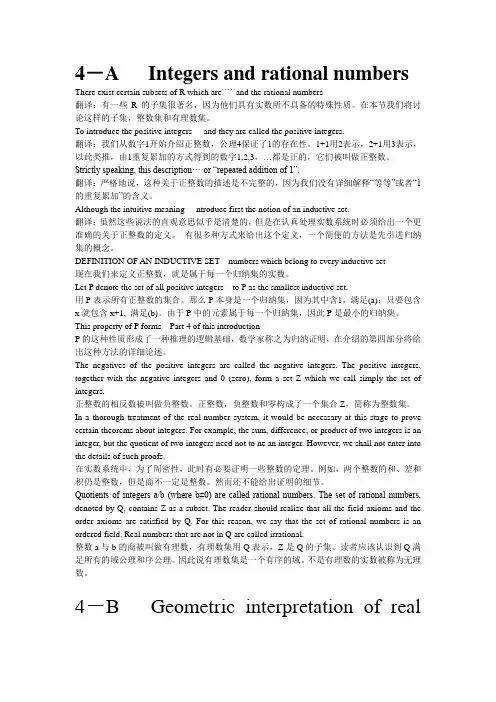
4-A Integers and rational numbers There exist certain subsets of R which are`````and the rational numbers翻译:有一些R的子集很著名,因为他们具有实数所不具备的特殊性质。
在本节我们将讨论这样的子集,整数集和有理数集。
To introduce the positive integers····and they are called the positive integers.翻译:我们从数字1开始介绍正整数,公理4保证了1的存在性。
1+1用2表示,2+1用3表示,以此类推,由1重复累加的方式得到的数字1,2,3,…都是正的,它们被叫做正整数。
Strictly speaking, this description····or “repeated addition of 1”.翻译:严格地说,这种关于正整数的描述是不完整的,因为我们没有详细解释“等等”或者“1的重复累加”的含义。
Although the intuitive meaning····ntroduce first the notion of an inductive set.翻译:虽然这些说法的直观意思似乎是清楚的,但是在认真处理实数系统时必须给出一个更准确的关于正整数的定义。
有很多种方式来给出这个定义,一个简便的方法是先引进归纳集的概念。
DEFINITION OF AN INDUCTIVE SET···numbers which belong to every inductive set现在我们来定义正整数,就是属于每一个归纳集的实数。
Let P denote the set of all positive integers···to P as the smallest inductive set.用P表示所有正整数的集合。

1、电器设备:electrical equipment2、铰接客车:articulated bus3、内燃机:internal combustion engine4、变矩器:torque converter5、差速器:differential gear6、传动轴:propeller shaft7、转向柱:steering column8、钢板弹簧:leaf spring9、螺旋弹簧:coil spring10、扭杆弹簧:torsion bar11、连杆:connection rod12、上止点:top read center13、下止点:bottom read center14、吸气行程:induction stroke15、做功行程:power stroke16、压缩行程:compression stroke17、排气行程:exhaust stroke18、有效容积:swept volume19、发动机排量:engine capacity20、转向系统:steering system21、传动系统:power train system22、制动系统:brake system23、车身:automobile body24、底盘:chassis25、发动机:engine26、电气系统:electrical system27、压缩比:compression ratio28、气缸体:cylinder block29、气缸盖:cylinder head30、顶置凸轮:overhead-cam31、灰铸铁:gray iron32、碳钢:carbon steel33、铝合金:aluminum alloy34、进气总管:internal manifold35、曲轴箱:crankcase36、活塞环(销):piston ring(pin)37、切向力:tangential force38、径向力:radial force39、气缸壁:cylinder wall40、气缸筒:cylinder bore41、往复运动:reciprocating motion42、点火次序:firing order43、人造橡胶:elastomer44、合成橡胶:synthetic rubber 45、气门间隙:valve clearance46、凸轮挺赶:cam follower47、气门正时:valve timing48、进气门:intake valve49、排气门:exhaust valve50、电子式气阀控制:electronic valve control51、顶置凸轮轴:overhead camshaft52、齿轮带:cog-type belt1、有些零件使汽车更舒服或更美观,但其中大多数是使汽车行驶。
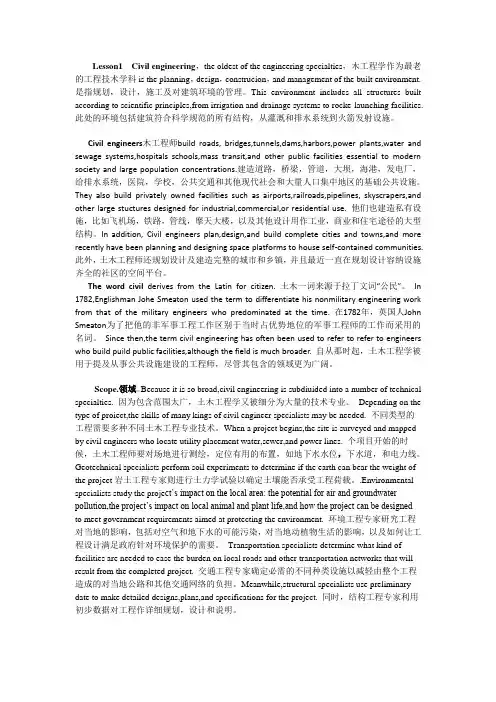
Lesson1 Civil engineering,the oldest of the engineering specialties,木工程学作为最老的工程技术学科is the planning,design,construcion,and management of the built environment. 是指规划,设计,施工及对建筑环境的管理。
This environment includes all structures built according to scientific principles,from irrigation and drainage systems to rocke-launching facilities. 此处的环境包括建筑符合科学规范的所有结构,从灌溉和排水系统到火箭发射设施。
Civil engineers木工程师build roads, bridges,tunnels,dams,harbors,power plants,water and sewage systems,hospitals schools,mass transit,and other public facilities essential to modern society and large population concentrations.建造道路,桥梁,管道,大坝,海港,发电厂,给排水系统,医院,学校,公共交通和其他现代社会和大量人口集中地区的基础公共设施。
They also build privately owned facilities such as airports,railroads,pipelines, skyscrapers,and other large stuctures designed for industrial,commercial,or residential use. 他们也建造私有设施,比如飞机场,铁路,管线,摩天大楼,以及其他设计用作工业,商业和住宅途径的大型结构。
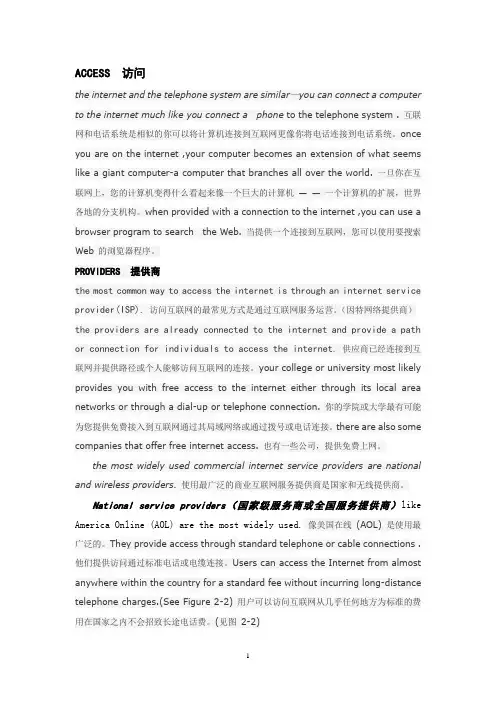
ACCESS 访问the internet and the telephone system are similar—you can connect a computer to the internet much like you connect a phone to the telephone system . 互联网和电话系统是相似的你可以将计算机连接到互联网更像你将电话连接到电话系统。
once you are on the internet ,your computer becomes an extension of what seems like a giant computer-a computer that branches all over the world. 一旦你在互联网上,您的计算机变得什么看起来像一个巨大的计算机——一个计算机的扩展,世界各地的分支机构。
when provided with a connection to the internet ,you can use a browser program to search the Web. 当提供一个连接到互联网,您可以使用要搜索Web 的浏览器程序。
PROVIDERS 提供商the most common way to access the internet is through an internet service provider(ISP).访问互联网的最常见方式是通过互联网服务运营。
(因特网络提供商)the providers are already connected to the internet and provide a path or connection for individuals to access the internet.供应商已经连接到互联网并提供路径或个人能够访问互联网的连接。
your college or university most likely provides you with free access to the internet either through its local area networks or through a dial-up or telephone connection. 你的学院或大学最有可能为您提供免费接入到互联网通过其局域网络或通过拨号或电话连接。

Chapter 1Passage 1 Human BodyIn this passage you will learn:1. Classification of organ systems2. Structure and function of each organ system3. Associated medical termsTo understand the human body it is necessary to understand how its parts are put together and how they function. The study of the body's structure is called anatomy; the study of the body's function is known as physiology. Other studies of human body include biology, cytology, embryology, histology, endocrinology, hematology, immunology, psychology etc.了解人体各部分的组成及其功能,对于认识人体是必需的。
研究人体结构的科学叫解剖学;研究人体功能的科学叫生理学。
其他研究人体的科学包括生物学、细胞学、胚胎学、组织学、内分泌学、血液学、遗传学、免疫学、心理学等等。
Anatomists find it useful to divide the human body into ten systems, that is, the skeletal system, the muscular system, the circulatory system, the respiratory system, the digestive system, the urinary system, the endocrine system, the nervous system, the reproductive system and the skin. The principal parts of each of these systems are described in this article.解剖学家发现把整个人体分成骨骼、肌肉、循环、呼吸、消化、泌尿、内分泌、神经、生殖系统以及感觉器官的做法是很有帮助的。
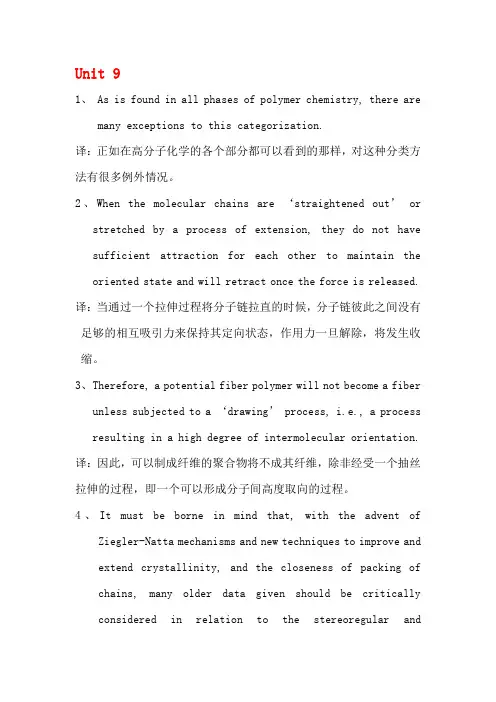
Unit 91、As is found in all phases of polymer chemistry, there aremany exceptions to this categorization.译:正如在高分子化学的各个部分都可以看到的那样,对这种分类方法有很多例外情况。
2、When the molecular chains are ‘straightened out’orstretched by a process of extension, they do not have sufficient attraction for each other to maintain the oriented state and will retract once the force is released. 译:当通过一个拉伸过程将分子链拉直的时候,分子链彼此之间没有足够的相互吸引力来保持其定向状态,作用力一旦解除,将发生收缩。
3、Therefore, a potential fiber polymer will not become a fiberunless subjected to a ‘drawing’process, i.e., a process resulting in a high degree of intermolecular orientation. 译:因此,可以制成纤维的聚合物将不成其纤维,除非经受一个抽丝拉伸的过程,即一个可以形成分子间高度取向的过程。
4、It must be borne in mind that, with the advent ofZiegler-Natta mechanisms and new techniques to improve and extend crystallinity, and the closeness of packing of chains, many older data given should be critically considered in relation to the stereoregular andcrystalline structure.译:必须牢牢记住,随着Ziegler-Natta机理出现,以及随着提高结晶度和提高链的堆砌密度的新方法的出现,对许多过去已得到的关于空间结构和晶体结构旧的资料,应当批判的接受。
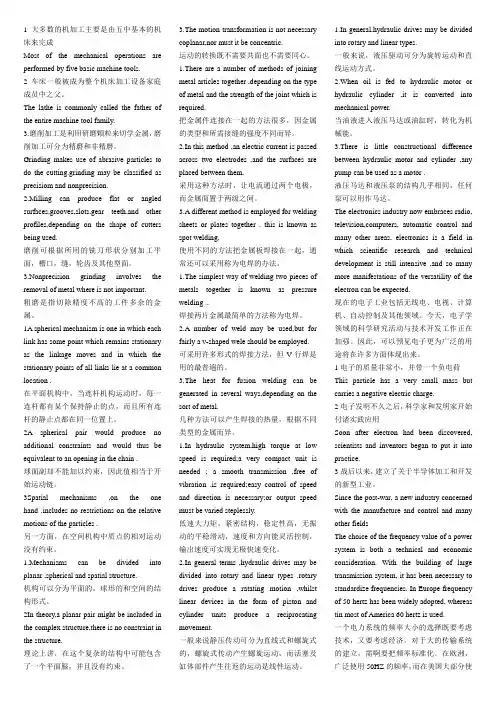
1大多数的机加工主要是由五中基本的机床来完成Most of the mechanical operations are performed by five basic machine tools.2车床一般被成为整个机床加工设备家庭成员中之父。
The lathe is commonly called the father of the entire machine tool family.3.磨削加工是利用研磨颗粒来切学金属,磨削加工可分为精磨和非精磨。
Grinding makes use of abrasive particles to do the cutting.grinding may be classified as precisiom and nonprecision.ling can produce flat or angled surfaces,grooves,slots,gear teeth,and other profiles,depending on the shape of cutters being used.磨削可根据所用的铣刀形状分别加工平面,槽口,缝,轮齿及其他型面。
3.Nonprecision grinding involves the removal of metal where is not important.粗磨是指切除精度不高的工件多余的金属。
1A spherical mechanism is one in which each link has some point which remains stationary as the linkage moves and in which the stationary points of all links lie at a common location .在平面机构中,当连杆机构运动时,每一连杆都有某个保持静止的点,而且所有连杆的静止点都在同一位置上。
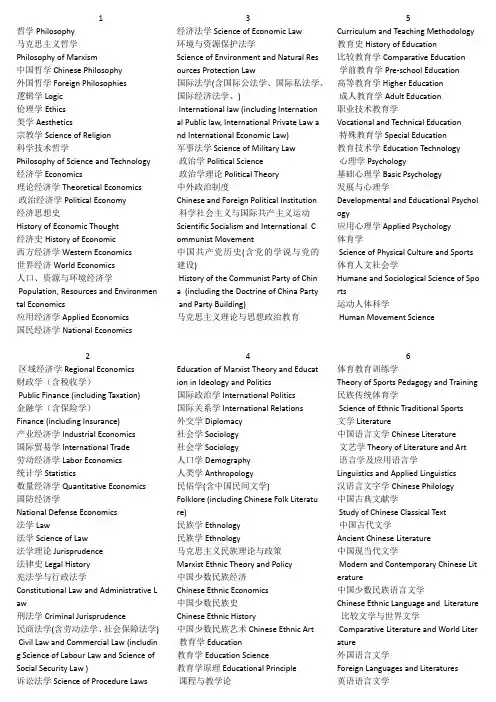
1哲学 Philosophy马克思主义哲学Philosophy of Marxism中国哲学 Chinese Philosophy外国哲学 Foreign Philosophies逻辑学 Logic伦理学Ethics美学 Aesthetics宗教学Science of Religion科学技术哲学Philosophy of Science and Technology 经济学 Economics理论经济学 Theoretical Economics政治经济学 Political Economy经济思想史History of Economic Thought经济史History of Economic西方经济学 Western Economics世界经济 World Economics人口、资源与环境经济学Population, Resources and Environmen tal Economics应用经济学 Applied Economics国民经济学National Economics2区域经济学 Regional Economics财政学(含税收学)Public Finance (including Taxation)金融学(含保险学)Finance (including Insurance)产业经济学 Industrial Economics国际贸易学 International Trade劳动经济学 Labor Economics统计学 Statistics数量经济学 Quantitative Economics 国防经济学National Defense Economics法学 Law法学 Science of Law法学理论 Jurisprudence法律史 Legal History宪法学与行政法学Constitutional Law and Administrative L aw刑法学 Criminal Jurisprudence民商法学(含劳动法学、社会保障法学) Civil Law and Commercial Law (includin g Science of Labour Law and Science of Social Security Law )诉讼法学 Science of Procedure Laws3经济法学 Science of Economic Law环境与资源保护法学Science of Environment and Natural Resources Protection Law国际法学(含国际公法学、国际私法学、国际经济法学、)International law (including International Public law, International Private Law and International Economic Law)军事法学 Science of Military Law政治学 Political Science政治学理论 Political Theory中外政治制度Chinese and Foreign Political Institution科学社会主义与国际共产主义运动Scientific Socialism and International Communist Movement中国共产党历史(含党的学说与党的建设)History of the Communist Party of China (including the Doctrine of China Partyand Party Building)马克思主义理论与思想政治教育4Education of Marxist Theory and Education in Ideology and Politics国际政治学 International Politics国际关系学 International Relations外交学 Diplomacy社会学 Sociology社会学 Sociology人口学 Demography人类学 Anthropology民俗学(含中国民间文学)Folklore (including Chinese Folk Literature)民族学 Ethnology民族学 Ethnology马克思主义民族理论与政策Marxist Ethnic Theory and Policy中国少数民族经济Chinese Ethnic Economics中国少数民族史Chinese Ethnic History中国少数民族艺术 Chinese Ethnic Art教育学 Education教育学 Education Science教育学原理 Educational Principle课程与教学论5Curriculum and Teaching Methodology教育史 History of Education比较教育学Comparative Education学前教育学Pre-school Education高等教育学 Higher Education成人教育学Adult Education职业技术教育学Vocational and Technical Education特殊教育学 Special Education教育技术学Education Technology心理学 Psychology基础心理学 Basic Psychology发展与心理学Developmental and Educational Psychology应用心理学 Applied Psychology体育学Science of Physical Culture and Sports体育人文社会学Humane and Sociological Science of Sports运动人体科学Human Movement Science6体育教育训练学Theory of Sports Pedagogy and Training民族传统体育学Science of Ethnic Traditional Sports文学 Literature中国语言文学 Chinese Literature文艺学 Theory of Literature and Art语言学及应用语言学Linguistics and Applied Linguistics汉语言文字学Chinese Philology中国古典文献学Study of Chinese Classical Text中国古代文学Ancient Chinese Literature中国现当代文学Modern and Contemporary Chinese Literature中国少数民族语言文学Chinese Ethnic Language and Literature比较文学与世界文学Comparative Literature and World Literature外国语言文学Foreign Languages and Literatures英语语言文学English Language and Literature俄语语言文学Russian Language and Literature法语语言文学French Language and Literature德语语言文学German Language and Literature日语语言文学Japanese Language and Literature印度语言文学Indian Language and Literature西班牙语语言文学Spanish Language and Literature阿拉伯语语言文学Arabic Language and Literature欧洲语言文学European Language and Literature亚非语言文学Asian-African Language and Literature 外国语言学及应用语言学Linguistics and Applied Linguistics in Fo reign Languages新闻传播学Journalism and Communication8新闻学 Journalism传播学 Communication艺术学 Art艺术学 Art Theory音乐学Music美术学 Fine Arts设计艺术学 Artistic Design戏剧戏曲学Theater and Chinese Traditional Opera 电影学 Film广播电视艺术学Radio and television Art舞蹈学 Dance历史学 History史学理论及史学史Historical Theories and History of Histo rical Science考古学及博物馆学Archaeology and Museology历史地理学 Historical Geography历史文献学(含敦煌学、古文字学) Studies of Historical Literature (includin g Paleography and Studies of Dunhuan g)专门史 History of Particular Subjects 中国古代史 Ancient Chinese History中国近现代史Modern and Contemporary Chinese History世界史 World History理学 Natural Science数学 Mathematics基础数学 Fundamental Mathematics计算数学 Computational Mathematics概率论与数理统计Probability and Mathematical Statistics应用数学 Applied mathematics运筹学与控制论Operational Research and Cybernetics物理学 Physics理论物理 Theoretical Physics粒子物理与原子核物理Particle Physics and Nuclear Physics原子与分子物理Atomic and Molecular Physics等离子体物理 Plasma Physics凝聚态物理Condensed Matter Physics声学 Acoustics10光学 Optics无线电物理Radio Physics化学Chemistry无机化学 Inorganic Chemistry分析化学 Analytical Chemistry有机化学 Organic Chemistry物理化学(含化学物理)Physical Chemistry (including ChemicalPhysics)高分子化学与物理Chemistry and Physics of Polymers天文学 Astronomy天体物理 Astrophysics天体测量与天体力学Astrometry and Celestial Mechanics地理学 Geography自然地理学 Physical Geography人文地理学Human Geography地图学与地理信息系统Cartography and Geography Information System大气科学 Atmospheric Sciences气象学 Meteorology大气物理学与大气环境Atmospheric Physics and AtmosphericEnvironment海洋科学 Marine Sciences物理海洋学 Physical Oceanography海洋化学 Marine Chemistry海洋生理学 Marine Biology海洋地质学 Marine Geology地球物理学 Geophysics固体地球物理学 Solid Earth Physics空间物理学 Space Physics地质学 Geology矿物学、岩石学、矿床学Mineralogy, Petrology, Mineral DepositGeology地球化学 Geochemistry古生物学与地层学(含古人类学)Paleontology and Stratigraphy (including Paleoanthropology)构造地质学 Structural Geology第四纪地质学 Quaternary Geology生物学 Biology植物学 Botany动物学 Zoology生理学 Physiology水生生物学 Hydrobiology12微生物学 Microbiology神经生物学 Neurobiology遗传学 Genetics发育生物学 Developmental Biology细胞生物学 Cell Biology生物化学与分子生物学Biochemistry and Molecular Biology生物物理学 Biophysics生态学 Ecology系统科学 Systems Science系统理论 Systems Theory系统分析与集成Systems Analysis and Integration科学技术史History of Science and Technology工学 Engineering力学 Mechanics一般力学与力学基础General and Fundamental Mechanics固体力学 Solid Mechanics流体力学 Fluid Mechanics工程力学 Engineering Mechanics机械工程 Mechanical Engineering机械制造及其自动化Mechanical Manufacture and Automation机械电子工程Mechatronic Engineering机械设计与理论Mechanical Design and Theory车辆工程Vehicle Engineering光学工程 Optical Engineering仪器科学与技术Instrument Science and Technology精密仪器及机械Precision Instrument and Machinery 测试计量技术及仪器Measuring and Testing Technologies an d Instruments材料科学与工程Materials Science and Engineering材料物理与化学Materials Physics and Chemistry材料学 Materialogy材料加工工程Materials Processing Engineering冶金工程Metallurgical Engineering 冶金物理化学of Metallurgy钢铁冶金 Ferrous Metallurgy14有色金属冶金 Non-ferrous Metallurgy 动力工程及工程热物理Power Engineering and Engineering Th ermophysics工程热物理Engineering Thermophysics热能工程Thermal Power Engineering 动力机械及工程Power Machinery and Engineering流体机械及工程Fluid Machinery and Engineering制冷及低温工程Refrigeration and Cryogenic Engineering 化工过程机械Chemical Process Equipment电气工程 Electrical Engineering电机与电器Electric Machines and Electric Apparatu s电力系统及其自动化Power System and its Automation高电压与绝缘技术High Voltage and Insulation Technology 电力电子与电力传动Power Electronics and Power Drives 电工理论与新技术Theory and New Technology of Electrical Engineering电子科学与技术Electronics Science and Technology物理电子学Physical Electronics电路与系统Circuits and Systems微电子学与固体电子学Microelectronics and Solid State Electronics电磁场与微波技术Electromagnetic Field and Microwave Technology信息与通信工程Information and Communication Engineering通信与信息系统Communication and Information Systems信号与信息处理Signal and Information Processing控制科学与工程Control Science and Engineering16控制理论与控制工程Control Theory and Control Engineering检测技术与自动化装置Detection Technology and Automatic Equipment系统工程 Systems Engineering模式识别与智能系统Pattern Recognition and Intelligent Systems导航、制导与控制Navigation, Guidance and Control计算机科学与技术Computer Science and Technology计算机软件与理论Computer Software and Theory计算机系统结构Computer Systems Organization计算机应用技术Computer Applied Technology建筑学 Architecture建筑历史与理论Architectural History and Theory建筑设计及其理论Architectural Design and Theory城市规划与设计(含风景园林规划与设计)Urban Planning and Design (including Landscape Planning and Design)建筑技术科学Building Technology Science土木工程 Civil Engineering岩土工程 Geotechnical Engineering结构工程Structural Engineering市政工程 Municipal Engineering供热、供燃气、通风及空调工程Heating, Gas Supply, Ventilating and AirConditioning Engineering防灾减灾工程及防护工程Disaster Prevention and Reduction Engineering and Protective Engineering桥梁与隧道工程Bridge and Tunnel Engineering水利工程 Hydraulic Engineering水文学及水资源Hydrology and Water Resources水力学及河流动力学Hydraulics and River Dynamics水工结构工程Hydraulic Structure Engineering18水利水电工程Hydraulic and Hydro-Power Engineering港口、海岸及近海工程Harbor, Coastal and Offshore Engineering测绘科学与技术Surveying and Mapping大地测量学与测量工程Geodesy and Survey Engineering摄影测量与遥感Photogrammetry and Remote Sensing地图制图学与地理信息工程Cartography and Geographic Information Engineering化学工程与技术Chemical Engineering and Technology化学工程 Chemical Engineering化学工艺 Chemical Technology生物化工 Biochemical Engineering应用化学 Applied Chemistry工业催化 Industrial Catalysis地质资源与地质工程Geological Resources and Geological Engineering矿产普查与勘探Mineral Resource Prospecting and Explo ration地球探测与信息技术Geodetection and Information Technolo gy地质工程 Geological Engineering矿业工程 Mineral Engineering采矿工程 Mining Engineering矿物加工工程Mineral Processing Engineering安全技术及工程Safety Technology and Engineering石油与天然气工程Oil and Natural Gas Engineering油气井工程Oil-Gas Well Engineering油气田开发工程Oil-Gas Field Development Engineering 油气储运工程Oil-Gas Storage and Transportation Engi neering纺织科学与工程Textile Science and Engineering纺织工程 Textile Engineering20纺织材料与纺织品设计Textile Material and Textiles Design纺织化学与染整工程Textile Chemistry and Dyeing and Finishi ng Engineering服装设计与工程Clothing Design and Engineering轻工技术与工程The Light Industry Technology and Engi neering制浆造纸工程Pulp and Paper Engineering制糖工程Sugar Engineering发酵工程Fermentation Engineering 皮革化学与工程Leather Chemistry and Engineering道路与铁道工程Highway and Railway Engineering交通信息工程及控制Traffic Information Engineering & Contr ol交通运输规划与管理Transportation Planning and Manageme nt载运工具运用工程Vehicle Operation Engineering船舶与海洋工程Naval Architecture and Ocean Engineering船舶与海洋结构物设计制造Design and Construction of Naval Architecture and Ocean Structure轮机工程 Marine Engine Engineering水声工程Underwater Acoustics Engineering航空宇航科学与技术Aeronautical and Astronautical Scienceand Technology飞行器设计 Flight Vehicle Design航空宇航推进理论与工程Aerospace Propulsion Theory and Engineering航空宇航器制造工程Manufacturing Engineering of Aerospace Vehicle人机与环境工程Man-Machine and Environmental Engineering22兵器科学与技术Armament Science and Technology武器系统与运用工程Weapon Systems and Utilization Engineering兵器发射理论与技术Armament Launch Theory and Technology火炮、自动武器与弹药工程Artillery, Automatic Gun and Ammunition Engineering军事化学与烟火技术Military Chemistry and Pyrotechnics核科学与技术Nuclear Science and Technology核能科学与工程Nuclear Energy Science and Engineering核燃料循环与材料Nuclear Fuel Cycle and Materials核技术及应用Nuclear Technology and Applications辐射防护及环境保护Radiation and Environmental Protection农业工程Agricultural Engineering农业机械化工程Agricultural Mechanization Engineering农业水土工程Agricultural Water-Soil Engineering农业生物环境与能源工程Agricultural Biological Environmental and Energy Engineering农业电气化与自动化Agricultural Electrification and Automation林业工程Forestry Engineering森林工程 Forest Engineering木材科学与技术Wood Science and Technology林产化学加工工程Chemical Processing Engineering of Forest Products环境科学与工程Environmental Science and Engineering环境科学Environmental Science环境工程Environmental Engineering生物医学工程Biomedical Engineering食品科学与工程Food Science and Engineering24食品科学 Food Science粮食、油脂及植物蛋白工程Cereals, Oils and Vegetable Protein Engineering农产品加工及贮藏工程Processing and Storage of Agriculture Products水产品加工及贮藏工程Processing and Storage of Aquatic Products农学 Agriculture交通运输工程Communication and Transportation Engineering作物学 Crop Science作物栽培学与耕作学Crop Cultivation and Farming System作物遗传育种学Crop Genetics and Breeding园艺学 Horticulture果树学 Pomology蔬菜学 Olericulture茶学 Tea Science农业资源利用学Utilization Science of Agricultural Resources土壤学 Soil Science植物营养学 Plant Nutrition植物保护学 Plant Protection植物病理学 Plant Pathology农业昆虫与害虫防治Agricultural Entomology and Pest Contr ol农药学 Pesticide Science畜牧学 Animal Science动物遗传育种与繁殖Animal Genetics, Breeding and Reprodu ction Science动物营养与饲料科学Animal Nutrition and Feed Science草业科学 Practaculture Science特种经济动物饲养学(含蚕、蜂等)The Rearing of Special-type Economic A nimals (including Silkworm, Honeybees, etc.) 兽医学 Veterinary Medicine基础兽医学Basic Veterinary Medicine 预防兽医学Preventive Veterinary Medicine临床兽医学26Clinical Veterinary Medicine林学 Forestry林木遗传育种学Forest Tree Genetics and Breeding森林培育学 Silviculture森林保护学Forest Protection森林经理学 Forest Management野生动植物保护与利用Wildlife Conservation and Utilization 园林植物与观赏园艺Ornamental Plants and Horticulture水土保持与荒漠化防治Soil and Water Conservation and Deser tification Combating水产学 Fisheries Science水产养殖学 Aquaculture Science捕捞学 Fishing Science渔业资源学Science of Fisheries Resources医学Medicine基础医学 Basic Medicine人体解剖与组织胚胎学Human Anatomy, Histology and Embry ology免疫学 Immunology 病原生物学 Pathogenic Organisms病理学与病理生理学Pathology and Pathophysiology法医学 Forensic Medicine放射医学Radiation Medicine航空航天与航海医学Aerospace and Nautical medicine临床医学 Clinical Medicine内科学(含心血管病学、血液病学、呼吸系病学、消化系病学、内分泌与代谢病学、肾脏病学、风湿病学、传染病学)Internal medicine (including Cardiology,Hematology, Respiratory, Gastroenterology, Endocrinology and Metabolism, Nephrology, Rheuma-tology, Infectious Diseases)儿科学 Pediatrics老年医学 Geriatrics神经病学 Neurology精神病与精神卫生学Psychiatry and Mental Health皮肤病与性病学Dermatology and Venereology28影像医学与核医学Imaging and Nuclear Medicine临床检验诊断学Clinical Laboratory Diagnostics护理学 Nursing外科学(含普通外科学、骨外科学、泌尿外科学、胸心血管外科学、神经外科学、整形外科学、烧伤外科学、野战外科学)Surgery (General Surgery, Orthopedics,Urology, Cardiothoracic Surgery, Neurosurgery, Plastic Surgery, Burn Surgery, Field Surgery)妇产科学 Obstetrics and Gynecology眼科学 Ophthalmic Specialty耳鼻咽喉科学 Otolaryngology肿瘤学 Oncology康复医学与理疗学Rehabilitation Medicine & Physical Therapy运动医学Sports Medicine麻醉学 Anesthesiology急诊医学 Emergency Medicine口腔医学 Stomatology口腔基础医学Basic Science of Stomatology口腔临床医学Clinical Science of Stomatology公共卫生与预防医学Public Health and Preventive Medicine流行病与卫生统计学Epidemiology and Health Statistics劳动卫生与环境卫生学Occupational and Environmental Health营养与食品卫生学Nutrition and Food Hygiene儿少卫生与妇幼保健学Maternal, Child and Adolescent Health卫生毒理学 Hygiene Toxicology军事预防医学Military Preventive Medicine中医学Chinese Medicine中医基础理论Basic Theories of Chinese Medicine中医临床基础Clinical Foundation of Chinese Medicine中医医史文献30History and Literature of Chinese Medicine方剂学 Formulas of Chinese Medicine中医诊断学Diagnostics of Chinese Medicine中医内科学 Chinese Internal Medicine中医外科学Surgery of Chinese Medicine中医骨伤科学Orthopedics of Chinese Medicine中医妇科学Gynecology of Chinese Medicine中医儿科学Pediatrics of Chinese Medicine中医五官科学Ophthalmology and Otolaryngoloy of Chinese Medicine针灸推拿学Acupuncture and Moxibustion and Tuina of Chinese medicine民族医学 Ethnomedicine中西医结合医学Chinese and Western Integrative Medicine中西医结合基础医学31Basic Discipline of Chinese and Western Integrative中西医结合临床医学Clinical Discipline of Chinese and Weste rn Integrative Medicine药学 Pharmaceutical Science药物化学 Medicinal Chemistry药剂学 Pharmaceutics生药学 Pharmacognosy药物分析学 Pharmaceutical Analysis 微生物与生化药学Microbial and Biochemical Pharmacy 药理学 Pharmacology中药学Science of Chinese Pharmacology军事学 Military Science军事思想学及军事历史学Military Thought and Military History 军事思想学 Military Thought军事历史学 Military History战略学 Science of Strategy军事战略学Military Strategy战争动员学 War Mobilization战役学Science of Operations32联合战役学 Joint Operation军种战役学(含第二炮兵战役学)Armed Service Operation (including Op eration of Strategic Missile Force)战术学 Science of Tactics合同战术学Combined-Arms Tactics 兵种战术学 Branch Tactics军队指挥学Science of Command作战指挥学 Combat Command军事运筹学Military Operation Research军事通信学Military Communication军事情报学Military Intelligence密码学 Cryptography军事教育训练学(含军事体育学) Military Education and Training (includi ng Military Physical Training)军制学Science of Military System军事组织编制学Military Organizational System军队管理学 Military Management军队政治工作学Science of Military Political Work33军事后勤学与军事装备学Science of Military Logistics and Military Equipment军事后勤学 Military Logistics后方专业勤务 Rear Special Service军事装备学 Military Equipment管理学 Management Science管理科学与工程Management Science and Engineering 工商管理学Science of Business Administration会计学 Accounting 企业管理学(含财务管理、市场营销学、人力资源管理学)Corporate Management (including Fina ncial Management, Marketing, and Hu man Resources Management)旅游管理学 Tourist Management技术经济及管理学Technology Economy and Management 农林经济管理学Agricultural and Forestry Economics & Management农业经济管理学34Agricultural Economics & Management 林业经济管理学Forestry Economics & Management公共管理学Science of Public Management行政管理学Administration Management社会医学与卫生事业管理学Social Medicine and Health Manageme nt教育经济与管理学Educational Economy and Management 社会保障学 Social Security土地资源管理学Land Resource Management图书馆、情报与档案学Science of Library, Information and Arch ival图书馆学Library Science情报学 Information Science档案学 Archival Science。
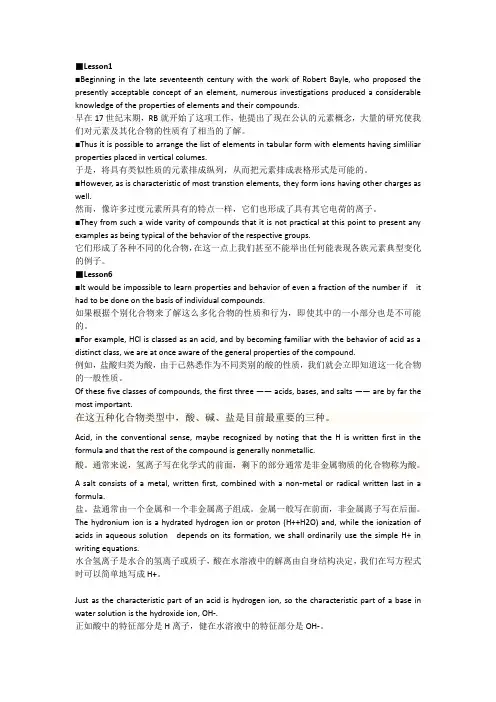
■Lesson1■Beginning in the late seventeenth century with the work of Robert Bayle, who proposed the presently acceptable concept of an element, numerous investigations produced a considerable knowledge of the properties of elements and their compounds.早在17世纪末期,RB就开始了这项工作,他提出了现在公认的元素概念,大量的研究使我们对元素及其化合物的性质有了相当的了解。
■Thus it is possible to arrange the list of elements in tabular form with elements having simliliar properties placed in vertical columes.于是,将具有类似性质的元素排成纵列,从而把元素排成表格形式是可能的。
■However, as is characteristic of most transtion elements, they form ions having other charges as well.然而,像许多过度元素所具有的特点一样,它们也形成了具有其它电荷的离子。
■They from such a wide varity of compounds that it is not practical at this point to present any examples as being typical of the behavior of the respective groups.它们形成了各种不同的化合物,在这一点上我们甚至不能举出任何能表现各族元素典型变化的例子。
(1)把握大局:grasp the overall situation (2) 摆谱儿:put on airs;keep up appearances (3)白手起家: start from scratch (4)拜年:pay New Year call (5)班门弄斧:teach one's grandma to suck eggs (5)保质期:guarantee period (6)报销:apply for reimbursement (7)爆冷门:produce an unexpected answer (8)曝光:make public (9)奔小康:strive for a relatively comfortable life (10)闭门羹:given cold-shoulder(11)比上不足,比下有余:fall short of the best,but be better than the best (12)逼上梁山:be driven to drastic alternatives (13)变相涨价:disguised inflation (14)边远贫困地区:outlying poverty-stricken areas (15)边缘知识人:Marginal intellectuals (16)表面文章:Lip service;surface formality (17) 博导:Ph.D supervisor (18)补发拖欠的养老金:Clear up pension payments in arrears (19)不眠之夜:white night (20)菜鸟:green hand (21)产品科技含量technoligical element of a product(22)长江三角洲:Yangtze River delta(23)长江中下游:the middle and lower reaches of Changjiang River (24)超前消费:pre-mature consumption (25)城镇居民最低生活保障:a minimum standard of living for residents (26)城镇职工医疗保险制度:the system of medical insurance for urban workers(27)重复建设:buiding redundant project;duplication of similar projects (28)充值卡:rechargeable card (29)春运:passenger transport around the Chinese lunar new year(30)打破僵局:break the deadlock/stalemate(31)电脑盲:computer illiterate(32)点球:penalty kick(33)电视会议:video conference(34)电视直销:TV home shopping(35)定向培训:training for specific posts (36)动感电影:multidimensional movie (37)豆腐渣工程:jerry-built projects (38)对...毫无顾忌:make no bones about (39)夺冠:take the crown (40)政治多元化:political pluralism (41)服务行业:catering industry(42)复合型人才:inter-disciplinary talent (43)岗位培训:on-the-job training(44)高等教育自学考试:self-study higher education examination (45)高新技术产业开发区:high and new technological industrial development zone (46)各大菜系:major styles of cooking (47)各行各业:every walk of life (48)功夫不负有心人:Everything comes to him who waits (49)各尽其能:let each person do his best (50)公益活动:public welfare activities(51)工薪阶层:state employee;salaried person (52)过犹不及:going too far ia as bad as not going far enough(53)函授大学:correspondence university (54)好莱坞大片:Hollywood blockbuster (55)核心竞争力:core competitiveness (56)虎父无犬子:A wise goose never lays a tame leg(57)基本国情:fundamental realities of the country(58)激烈竞争:cut-throat competition (59)极限运动:maximal exercise/X-games(60)集中精力把经济建设搞上去:go all out for economic development (61)加班:work extra shifts (62)嘉宾:distinguished/honored guest (63)加快市场步伐:quicken the pace of marketization (64)假冒伪劣产品:counterfeit and shoddy products(65)减负:alleviate burdens on sb(66)江南水乡:the south of the lower reaches of the Yangtze River (67)教书育人:impart knowledge and educate people (68)脚踏实地:be down-to-earth(69)解除劳动关系:sever labor relations(70)扩大内需:expand domestic demand (71)拉拉队:cheering squad (72)论文答辩:(thesis)oral defence (73)马到成功:achieve immediate victory(74)三维电影/动画片:three-dimensional movie/animation(75)森林覆盖率:forest coverage (76)社会保险机构:social security institutions (77)社会热点问题:hot spots of society (78)社会治安情况:law-and-order situation(79)申办城市:the bidding cities(80):身体素质:physical constitution(81)生计问题:bread-and-butter issue (82)生意兴隆:business flourishes (82)市场疲软:sluggish market(83)市政工程:municipal works/engineering(84)事业单位:public institution (85)试用期:probationary period (86)首创精神:pioneering spirit (87)手机充值:cellular phone replenishing(88)台湾同胞:Taiwan compatriots(89)脱贫致富:cast off poverty and set out on a road to prosperity(90)西部大开发:Development of the West Regions(91)新秀:up-and-coming star(92)学生处:students' affairs division (93)舆论导向:direction of public opinion (94)招生就业指导办公事:enrolment and vocation guidance office (95)支柱产业:pillar conerstone industry (96)中专生:secondary specialized or technical school student (97)专题报道:special coverage (98)《阿Q正传》:The True Story of Ah Q(99)《春秋》:Spring and Autumn Annals (100)知识产权:intellectual property rights。
1. Electrical Measuring Instruments电子测量仪表Electrical personnel use many different types of measuring instruments. 电子技术人员使用许多不同类型的测量仪器。
Some jobs require very accurate measurements while other jobs need only rough estimates. 一些工作需要精确测量面另一些工作只需粗略估计。
Some instruments are used solely to determine whether or not a circuit is complete. 有些仪器被使用仅仅是确定线路是否完整。
The most common measuring and testing instruments are voltage testers, voltmeters, ammeters, ohmmeters, continuity testers, megohmmeters, wattmeters(功率计), and watt-hour meters(电度表,电表)。
最常用的测量测试仪表有:电压测试仪,电压表,欧姆表,连续性测试仪,兆欧表,瓦特表还有瓦特小时表。
All meters used for measuring electrical values are basically current meters. 所有测量电值的表基本上都是电流表。
They measure or compare the values of current flowing through them. 他们测量或是比较通过他们的电流值。
The meters are calibrated and the scale is designed to read the value of the desired unit. 这些仪表可以被校准并且设计了不同的量程,以便读出期望的数值。
Unit one :Environmental Engineering环境工程What is this book about?这本书是关于什么的?The objective of this book is to introduce engineering and science students to the interdisciplinary study of environment problems;their cause,why they are of concern,and how we can control them. The book includes:这本书的目的是使理工科的学生了解跨学科间的研究环境问题;它们的起因,为什么它们受到关注,以及我们怎样控制它们。
这本书包括:●Description of what is meant by environment and environmental systems描述环境和环境系统意味着什么●Information on the basic causes of environmental disturbances关于引起环境干扰基础原因的基本信息●Basic scientific knowledge necessary to understand the nature of environmentalproblems and to be able to quantify them理解环境问题本质,并能够定量计算它们所必要的基本科学知识●Current state of the technology of environmental control in its application towater,air and pollution problems目前适用于水,空气和环境污染问题的环境控制技术的现状●Considerable gaps in our current scientific knowledge of understanding andcontrolling many of the complex interactions between human activities and nature我们目前的科学知识在理解和控制人类活动和自然之间复杂的相互作用的科学知识上存在相当大的缺陷●Many environmental problems which could be eliminated or reduced by theapplication of current technology,but which are not dealt with because of society’s lack of will to do so,or in many instance because of a lack of resources to do so.许多环境问题可以应用现有技术消除或减少,但没有得到处理是因为社会缺乏这样做的意愿,或者像许多例子那样因为缺乏资源。
1.一般工程钢(淬火和回火钢)经过简单正火处理后的碳素钢(碳含量0.25—0.60%,最大含Mn量1.0%),广泛应用于棒条、一般工程锻件、落垂锻件中。
对于给定的材料的最佳性质组合只体现在不超过一定尺寸的组件中,对于碳钢来说,这个尺寸很小(低限制的最大截面)。
这些碳素钢经过淬火和回火后可以获得优良的拉伸强度、屈服强度、延伸性和抗冲击性。
任何一种钢都有一个最小的冷却速度以产生有效硬化。
同样,热量被淬火介质吸收的速度也会受到最大截面的影响。
虽然有可能通过淬火来硬化特定钢材的小截面,但对于同一钢材的大截面,就不一定了。
这种质量效应和尺寸效应深深地影响着用于淬火和回火的钢的选择。
对于碳素钢来说,要达到满意的硬化效果,冷却速度必须很大,因此,能进行理想热处理的钢材,截面尺寸是有限制的。
而且,在金属中发生相变的参数是其均匀性质是不能赋予给超过一定厚度的工件,因为中心和截面表面之间出在不同的冷却速度。
更进一步说,具有高拉伸强度的普通钢,通常带有相对低的屈服点,并且延展性和韧性都低。
因此,普通碳素钢仅仅可能获得中等的拉伸强度水平与合理的延展性和韧度。
因此,想获得大尺寸和高的拉伸强度的要求,就需要用一种即使在低的淬火热吸收率下也能得到有效硬化的钢。
通过使用合金钢,这些难题便迎刃而解。
通过加入合金元素,如锰、镍、铬、钼、钒,降低了使钢有效硬化的最低冷却速度,这取决于添加元素的含量或元素的组合。
此外,组件的畸变和裂纹也减少了。
多种合金元素总和的应用比单一元素更为广泛。
这是由于有很多种元素同时存在的任一截面起的效果比起有等值的单一元素存在的截面起的效果要大。
此外,某些元素具有的缺点会抵消它们的优点,这就有必要限制它们在金属中的量。
我们也能发现,某些元素组合各自所具有的优点抵消各自的缺点,同时其他优点共同起作用。
铬的单一使用会使晶粒粗化,而镍在长时间加热时也能使含碳量高的钢产生碳化。
铬能够稳定碳化物的出现,而镍帮助晶粒优化。
FREEWAY TRAFFIC FLOW MODELING BASED ON RECURRENT NEURAL NETWORK AND WAVELET TRANSFORM基于递归神经网络和小波变换的高速公路交通流建模6 Conclusions 结论The highly nonlinear and dynamic characteristics of the macroscopic traffic flow require a modeling approach, which can deal with the complex nonlinear relationships among the speed, flow and density.宏观交通流的高度非线性和动态特性,需要一个建模方法,它可以处理的速度,流量和密度之间的复杂的非线性关系。
At the same time, effective measures have to be taken to eliminate traffic noise and disturbance. In this paper, a method of wavelet denoising and traffic flow modeling by an Elman recurrent neural network is presented.同时,必须采取有效措施来消除交通噪声和干扰。
在本文中,一种小波去噪和交通流的Elman神经网络建模这工作了。
Simulation results show that the wavelet transform can effectively eliminate the noise signal, and that the Elman network can accurately describe the real behavior of freeway traffic flow.仿真结果表明,小波变换可以有效地消除信号中的噪声,和Elman神经网络能够准确地描述高速公路交通流的真实行为。
This method is of great importance to realize on-line modeling and control of freeway traffic flow.此方法对实现高速公路交通流的在线建模与控制具有重要意义。
Fuzzy Self-Adaptive PID Controller for Freeway Ramp Metering高速公路匝道控制的模糊自适应控制器Abstract:Aiming at the nonlinear and time-varying characteristics of freeway traffic system, a fuzzy self-adaptive PID controller is designed and applied to freeway ramp metering in this paper.摘要:针对高速公路交通系统的非线性、时变特性,设计了一种模糊自适应控制器,并将其应用于高速公路匝道控制系统。
A traffic flow model to describe the freeway flow process is firstly built. Based on the model and in conjunction with nonlinear feedback theory, a fuzzy-PID ramp controller is then designed. The ramp metering rate is determined by the PID controller whose parameters are tuned by fuzzy logic according to the density tracking error and error variation.首先建立了一个交通流模型来描述高速公路的流程。
基于该模型,并结合非线性反馈理论,一个模糊的控制器,控制器,然后设计。
斜坡根据密度跟踪误差和误差变化情况,通过模糊逻辑对控制器参数进行调整,确定了测量速度。
Gauss and triangle curves are used for the membership functions of the fuzzy variables. The rule base including 49 fuzzy rules is also established. Finally, the control system is simulated in MATLAB software. The results show that this controller designed has fast response, good dynamic and steady-state performance. It can achieve a desired traffic density along the mainline of a freeway, and can make vehicles travel more efficiently and safely. This approach is quite effective to freeway ramp metering.高斯和三角曲线用于模糊变量的隶属函数。
还建立了包括49个模糊规则的规则库。
最后,对控制系统进行了仿真研究的软件。
结果表明,该控制器具有响应快、动态性能和稳态性能。
它可以实现所需的交通密度,高速公路主线,并能使车辆行驶更安全、更安全。
这种方法是相当有效的高速公路匝道控制。
2. Freeway Traffic Flow Model高速公路交通流模型Consider a multiple lane (λ) freeway section with a single entry ramp, as shown in figure 1. 考虑多车道(λ)具有单一入口匝道路段,如图1所示。
Assume that at time slice k, vehicles flow into a given section at a rate of qu(k) vehicles per hour per lane from its upper boundary and r(k) vehicles per hour from the entry ramp.假设在时间片上,车辆进入一个给定的区段在一个区段(克)每车道从它的上边界和(钾)车辆每小时从入口匝道的速度。
They discharge at a rate of q(k) vehicles per hour per lane at its lower boundary. 他们以每小时的速度在其较低的边界处排放一个问(克)的车辆。
By the conservation principle, the number of vehicles in this freeway segment at time 按养护原则,在这条高速公路的车辆数量在时间 k+1, N(k+1) would be )]()()([)()1(k r k q k q t k N k N u +-∆+=+λλ (1)Δxq u ρ v qrFigure 1 A freeway section )]()()([)()1(k r k q k q t k N k N u +-∆+=+λλ (1)Define traffic density as , where is length of the road segment. Equation (1) can now be written in terms of density 定义交通密度,哪里是公路段的长度。
方程(1)现在可以用密度来书写]/)()()([)/()()1(λρρk r k q k q x t k k u +-∆∆+=+(2)Empirical evidence suggests that a relationship between flow and traffic density exists. This relationship, denoted as is generally referred to as the fundamental diagram of traffic flow. Many forms of fundamental diagrams have been proposed, all of which share some common features: 经验证据表明,流量和交通密度之间的关系存在。
这种关系,表示为通常被称为交通流基本图。
许多形式基本图已经被提出,所有这些都有一些共同的特点:(1) flow is zero when density is zero; (2) there is a maximum density (often referred to as jam density) that corresponds to bumper-to-bumper traffic (at which flow is also zero); and (3) there exists a traffic density at which flow is maximal (often referred to as critical density). (1)密度为零时的流量为零;(2)有一个最大密度(通常称为果酱密度),对应于保险杠到保险杠的流量(在流量也是零);(3)存在流量最大的交通密度(通常称为临界密度)。
When traffic density is below critical density, flow increases with density; and when traffic density is above critical density, flow decreases with density.交通密度低于临界密度时,流量随密度增大而增大;当交通密度超过临界密度时,流量随密度的增加而减小。
Equation (2) and the fundamental diagram constitute a discrete form of the well known traffic flow model called LWR model [4]. 方程(2)和基本图构成的离散的众所周知的交通流模型的LWR模型[ 4 ]形式。